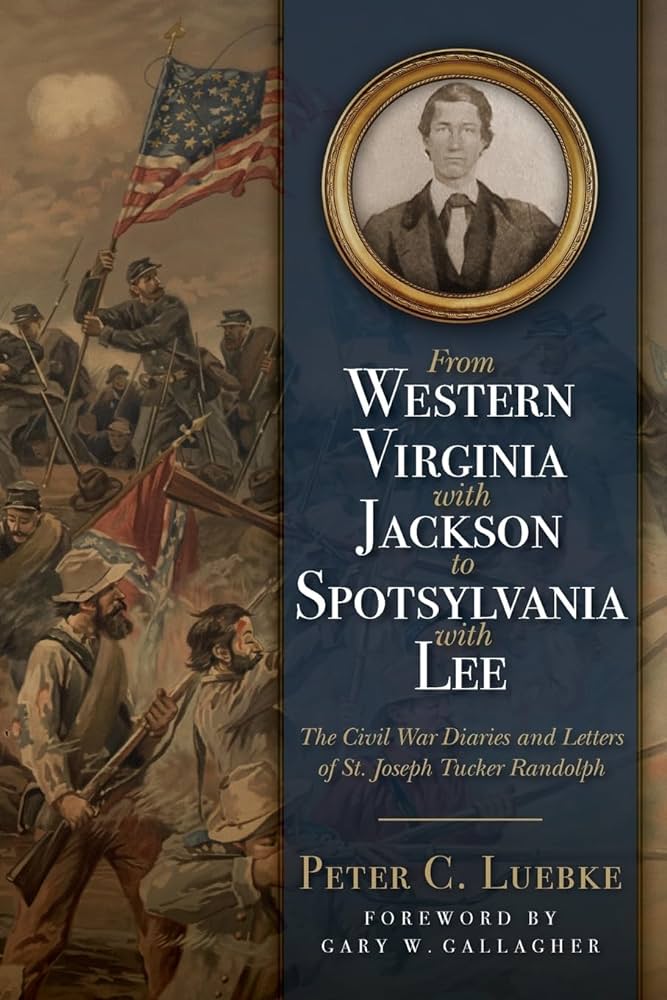Book Review: From Western Virginia with Jackson to Spotsylvania with Lee: The Civil War Diaries and Letters of St. Joseph Tucker Randolph

 From Western Virginia with Jackson to Spotsylvania with Lee: The Civil War Diaries and Letters of St. Joseph Tucker Randolph. Edited by Peter C. Luebke. Charleston, WV: 35th Star Publishing, 2023. Softcover, 246 pp. $15.95.
From Western Virginia with Jackson to Spotsylvania with Lee: The Civil War Diaries and Letters of St. Joseph Tucker Randolph. Edited by Peter C. Luebke. Charleston, WV: 35th Star Publishing, 2023. Softcover, 246 pp. $15.95.
Reviewed by Tim Talbott
Despite the increasing availability of online digitized primary sources, such as Civil War soldier’s letters, the simple fact is that there are still numerous rich and compelling collections that will never be available digitally. Thankfully, readers continue to seek out and purchase edited diary and letter collections, and therefore publishers continue to see the value in printing them.
One recently published collection, that from the pen of St. Joseph Tucker Randolph, and edited by Peter C. Luebke, appears under the title From Western Virginia with Jackson to Spotsylvania with Lee, and offers readers an fascinating picture of a well-traveled young Virginian.
St. Joseph Tucker Randolph, who went by and signed his letters as Tucker, was the 17-year-old son of a slaveholding Richmond bookseller when he joined a local militia unit the year following John Brown’s raid. The militia unit later became Company F in the 21st Virginia Infantry, not long after the Old Dominion seceded.
Tucker Randolph left “a small pocket diary, a larger diary, and numerous letters” that documented his career as a Confederate soldier (5). Kept in the collections of the Museum of the Confederacy for years, and now among the holdings of the American Civil War Museum in Richmond, Luebke became aware of the letters and diaries while serving a summer internship at the Museum of the Confederacy. His on and off again work researching and transcribing these documents covers almost the last two decades.
Information about Randolph’s early service comes largely by way of his numerous diary entries beginning in the spring of 1861, when he was stationed in Richmond. Eventually, with his regiment’s transfer to more distant locales, Randolph began writing letters to his family. He must have been a particularly impressive young soldier, as he began his career as a corporal and later received a promotion to first sergeant while with the 21st Virginia.
Randolph’s 1861-62 diary entries and letters cover many common soldier life topics including his clothing, weather and health reports, maintaining family connections, and food and pay concerns. Luebke has arranged Randolph’s letters and diary entries to maintain proper chronological order so that they provide a good flow for the reader rather than separating them into the two separate formats (diaries and letters) and risking losing story cohesion.
On March 23, 1862, Randolph received a wound to his stomach at the Battle of Kernstown. He recuperated at home, but his wounding created a void in his documentation and thus little is known of his service between April and September 1862. When his letter writing resumes in the fall of 1862, he had transferred to the western theater, serving with Gen. Henry Heth and Col. Henry Marshall Ashby’s cavalry in Gen. Edmund Kirby Smith’s small army during the Kentucky Campaign. Another hole in Randolph’s service appears from December 1862 to October 1863, when he apparently served on the staff of Brig. Gen. John Pegram, who commanded cavalry at that time. When Pegram received a transfer to the eastern theater and the Army of Northern Virginia in order to command an infantry brigade in Lt. Gen. Richard Ewell’s corps, Randolph came with Pegram.
To help fill in some of the blank spots in the documentation of Randolph’s military career and to add to what exists, Luebke wisely incorporates accounts from others in Tucker’s close association, such as John Worsham, who was Randolph’s close friend in the 21st Virginia, and who wrote One of Jackson’s Foot Cavalry. Another account comes from Raleigh Travers Daniel, who served on John Pegram’s staff with Randolph. Portions of both accounts are included in the book.
Once back in Virginia, Randolph’s letters to his parents pick back up in fall of 1863 and continue through the spring of 1864. Randolph traveled with Pegram after the brigadier received a serious wound in the Wilderness, but returned to the brigade at Spotsylvania in time to witness the terrible combat on May 12 at the Muleshoe, and later on May 18 at Harris Farm. When Grant moved south after Spotsylvania and Lee beat him to the North Anna, unfortunately Randolph’s days were numbered. In the fighting that preceded Cold Harbor, he fell killed in action on May 30, 1864, at Bethesda Church (Totopotomoy Creek).
Luebke’s skillful editing make Randolph’s missives a pleasure to read, while the endnotes and aforementioned complementary accounts add to the book’s educational value. Selected images of people and places mentioned in Randolph’s diaries and letters supplement his writings. Excellent maps by Edward Alexander help orient readers to the various locations in which Randolph experienced the war.
From Western Virginia with Jackson to Spotsylvania with Lee certainly makes a valuable contribution to our understanding of the common soldier’s experience and just how transitional some soldiers’ Civil War service could be. This study can claim a worthy spot among the appreciated published diary and letter collections of other Civil War soldiers, and is sure to become a go to source for researchers.
Sounds like an excellent resource. Re-enactors would get alot out of the book for the purpose of getting their mindset right.